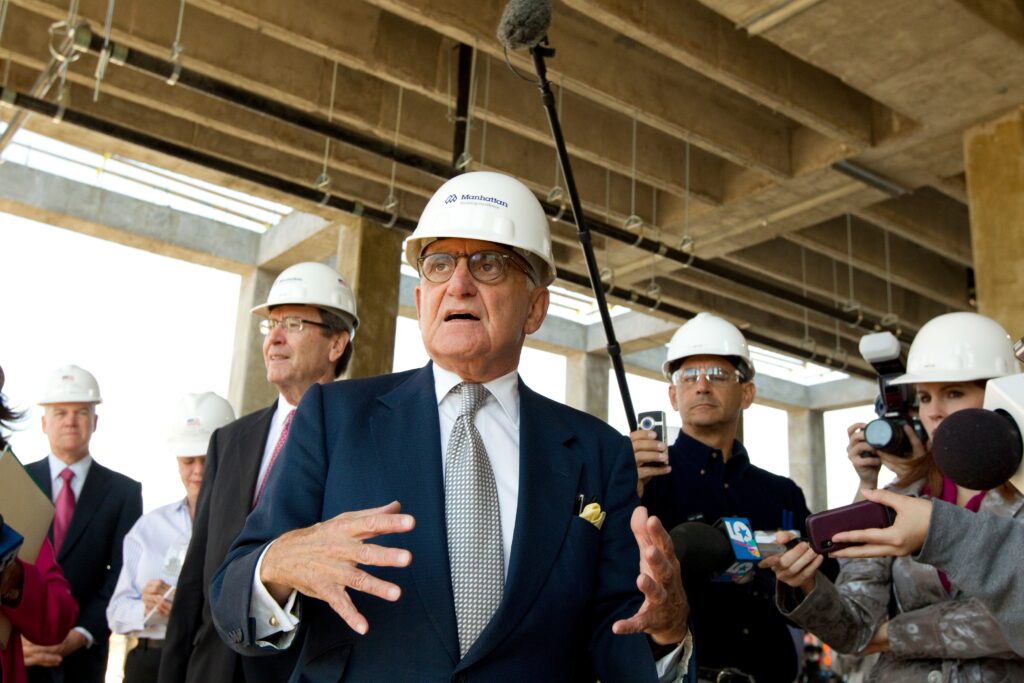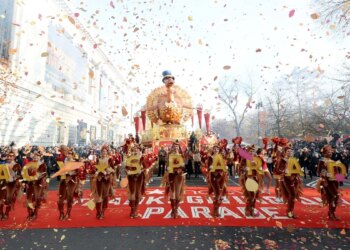Robert A.M. Stern, one of the most prolific American architects of the past 60 years, whose historically detailed buildings conferred gravitas on individuals and institutions, died Nov. 27 at his home in Manhattan. He was 86.
The cause was a brief pulmonary illness, said his son, Nicholas Stern.
In a multifaceted career, Mr. Stern led the Yale School of Architecture from 1998 to 2016; was the author or co-author of more than two dozen books, including a multivolume history of New York City architecture, and appeared in countless documentaries. In the mid-1980s, he hosted “Pride of Place: Building the American Dream,” an eight-part series on PBS.
His Manhattan-based firm, Robert A.M. Stern Architects, or RAMSA, was well known for designing houses in such wealthy enclaves as the Hamptons, Martha’s Vineyard and Palm Beach. Many resembled 100-year-old “Shingle Style” mansions. Others were carefully detailed interpretations of even older styles.
The firm was also known for its luxurious apartment towers. In Manhattan they included 15 Central Park West, a limestone-clad condominium at the southwest corner of Central Park. Modeled on storied New York buildings erected before World War II, it became by some measures the most successful condominium building in the city’s history. Initial sales in the building, which opened in 2008, totaled more than $2 billion.
The firm’s other condo buildings include 30 Park Place, just west of the Woolworth Building in Lower Manhattan, and the Chatham, where he lived on the Upper East Side. Outside Manhattan, RAMSA towers included the Century in Los Angeles; One Bennett Park in Chicago; the Morgan in Hong Kong; and Audley Square in London.
The firm was also known for university buildings, including the Darden School of Business at the University of Virginia; Weill Hall at the University of Michigan; and Miller Hall at the College of William & Mary in Williamsburg, Virginia, among many others. RAMSA also produced hotels, museums, libraries, courthouses, theaters, stores, houses of worship and corporate headquarters.
In Washington, Mr. Stern designed several office and apartment buildings, and his firm had a decades-long relationship with Georgetown University, working as a master planner and designing several residence halls.
In 2007, Mr. Stern was chosen to design the George W. Bush Presidential Center on the campus of Southern Methodist University in Dallas. He was criticized for producing a somewhat grandiose but limply historical building.
In an interview for this obituary in 2019, Mr. Stern called it “a traditional building with modern overtones,” adding, “One of the best things about it is that it fits into the campus of SMU, which is an exclusively Georgian-style campus.” He praised the president of SMU for “keeping his campus coherent.”
A dapper dresser and witty conversationalist, Mr. Stern was the ultimate insider, working for Rockefellers and Rothschilds and such universities as Yale and Princeton (where he designed the Center for Jewish Life in the early 1990s). Yet he seemed to enjoy tweaking the architectural establishment.
He began rejecting modernism, with its emphasis on unadorned and repetitive forms, early in his career. At first, he added historical details to otherwise modernist buildings — the cut-and-paste approach known as postmodernism. Later, he began designing buildings that were more wholeheartedly traditional. But his buildings tended to be bigger and slicker than the structures they were based on.
In 2017, Inga Saffron, the architecture critic of the Philadelphia Inquirer, called Mr. Stern’s Museum of the American Revolution, modeled on such nearby buildings as Independence Hall, “overblown in scale . . . like a sprawling banquet hall that happens to operate a small museum.” But, she added, “The museum board certainly knew what it was getting into when it hired Robert A.M. Stern as its architect.” Mr. Stern, she wrote, “has made a profitable business out of producing stylized modern interpretations of historic architecture.”
Mr. Stern was adept at parrying criticism of his approach. “You learn through imitation,” he once told the New York Times, “which is very different from copying. Copying is what a Xerox machine does; imitation is what an artist does.”
Yearning for Manhattan
Robert Arthur Morton Stern was born in Brooklyn on May 23, 1939, and grew up in a one-bedroom apartment. His father held various jobs, including driving a taxi; his mother sold china at the B. Altman department store on Fifth Avenue.
“I disliked Brooklyn; it was a place to be from and get out of,” Mr. Stern wrote in his 2022 memoir, “Between Memory and Invention: My Journey in Architecture.” Manhattan on the other hand, “was a kind of metropolitan Oz.”
He graduated from Columbia University in 1960 and received a master of architecture degree from Yale in 1965. Many of his professors at Yale were devotees of the modern orthodoxy propounded by the Bauhaus, the German architecture school founded by Walter Gropius before World War II.
“I’m an anti-Bauhaus person because I didn’t jettison the historical styles,” he told Architectural Record magazine in 2019. “The architecture that came out of the Bauhaus isn’t very interesting.” At Yale his few allies included architectural historian Vincent Scullyand architect Philip Johnson, neither of whom saw modernism as the only acceptable style.
After Yale, Mr. Stern worked at the Architectural League of New York as program director, and then for architect Richard Meier. In 1977, after several years in partnership with a Yale classmate, John S. Hagmann, he founded Robert A.M. Stern Architects. The firm eventually grew to 17 partners and more than 300 employees.
One of his great patrons was Michael Eisner, the Disney chairman and chief executive at whose behest Mr. Stern designed several projects in central Florida, including Disney’s Yacht Club Resort and Disney’s Beach Club Resort. Mr. Stern was also the master planner for Celebration, Florida, an attempt by Disney to create an ideal suburban community.
Its resemblance to a stage set was enchanting to some and off-putting to others. The Wall Street Journal reported that Eisner “acknowledged some early touches — such as music twinkling from inside bushes — were a bit over the top.”
Mr. Stern’s design for the Walt Disney Feature Animation Building, in Burbank, California, included, over its main entrance, a monumental version of Mickey Mouse’s hat from “The Sorcerer’s Apprentice” sequence in the Disney film “Fantasia.” For more than a decade, Mr. Stern was a member of Disney’s board of directors.
His honors included the Driehaus Architecture Prize, awarded to exponents of classical architecture.
For years, Mr. Stern amazed the world of architecture with his enormous productivity — running a successful firm while spending much of his time teaching, first at Columbia and then at Yale, where he was an ecumenical dean, bringing architects of all persuasions to the school.
“He wants to hear arguments and discussions,” Deborah Berke, a longtime Yale professor (and Mr. Stern’s successor as dean) told the New Yorker in 2015. During his tenure, the school completed a much-praised renovation of its Art and Architecture Building, a brutalist masterpiece by Paul Rudolph, himself a former Yale architecture dean.
Near the end of his time as dean, Mr. Stern received a plum commission from Yale: the chance to design two new residential colleges intended to house 450 undergraduates each. His plans drew directly from the work of James Gamble Rogers, who designed much of Yale in the collegiate Gothic style between the world wars.
The critical reaction to the new colleges, called Pauli Murray College and Benjamin Franklin College, was mixed. Blair Kamin, writing in the Chicago Tribune in 2017, described them as “strong, city-enhancing buildings … graced with commodious, tradition-tinged rooms that students who grew up reading Harry Potter novels can be expected to appreciate.” Yet he decried their “inconsistency and lapses into excess.”
Mr. Stern, who continued teaching at Yale after stepping down as dean in 2016, was an ardent preservationist. He spearheaded efforts to save unpopular buildings, including modernist structures that appealed to him as an architectural historian. “We have to rise above our prejudices,” he told the Times in 1996, when he compiled a list of 35 modern buildings in New York that he believed deserved landmark status.
Like many other firms, RAMSA documented its work in coffee-table books. But Mr. Stern also supervised and subsidized the publication of books on architectural history, including the exhaustive “New York” series, written with a changing cast of co-authors employed by RAMSA. They ran (chronologically) from “New York 1880: Architecture and Urbanism in the Gilded Age” to “New York 2000: Architecture and Urbanism Between the Bicentennial and the Millennium.”
In 1966, he married photographer Lynn Gimbel Solinger, a granddaughter of Bernard Gimbel, the department store magnate, whom he met while working in the mayoral campaign of John V. Lindsay. The marriage ended in divorce. Survivors include their son, Nicholas, a builder of high-end houses and apartments; a brother; and three grandchildren.
At the Chatham, Mr. Stern lived on a low floor, he said, so that he could see a garden and “hear the birdies.” But he also had views of three of his own buildings: 520 Park Avenue, 220 Central Park South, and 15 Central Park West.
“I’m very proud of them,” he said in the 2019 interview, “because they’ve had an impact not just on the skyline, but on what constitutes quality construction in the 21st century.” He added: “They follow my philosophy: You have to go back to go forward.”
The post Robert A.M. Stern, renowned architect and educator, dies at 86 appeared first on Washington Post.




